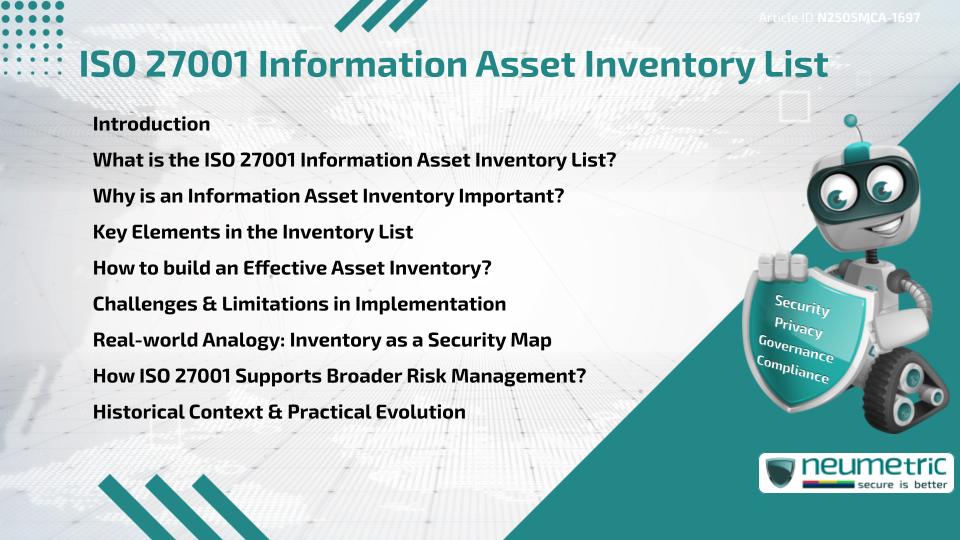Table of Contents
ToggleIntroduction
Every Business holds Information worth protecting. The ISO 27001 Information Asset Inventory List helps organisations identify & manage these Assets to support their Information Security Management System (ISMS). It’s more than a Compliance formality — it’s a foundational Tool for securing Sensitive Data.
What is the ISO 27001 Information Asset Inventory List?
This Inventory is a structured list of both Physical & Digital Information Assets that are relevant to the Organisation’s Operations. According to ISO/IEC 27001, every Asset that Stores, Processes or Transmits Information should be catalogued with details like Ownership, Classification & Location.
Why is an Information Asset Inventory Important?
You can’t secure what you haven’t identified. The ISO 27001 Information Asset Inventory List offers visibility across Systems, Devices & Data types. It supports Access Control, Risk Management & Response Planning. For example, if a Laptop with Confidential Data is lost, the list helps trace its Owner, Classification & Related Risks.
Key Elements in the Inventory List
A strong Asset Inventory includes:
- Asset Name & Description
- Physical or Digital Location
- Assigned Owner or Custodian
- Classification Level (Public, Internal, Confidential, etc.)
- Linked Systems or Dependencies
- Related Risks or Controls
These elements provide the context needed for effective Security decisions.
How to build an Effective Asset Inventory?
Start with Core Infrastructure: Laptops, Servers, Cloud Tools & Key Databases. Then expand to softer elements like Internal Documentation or Credentials. Use Automated Tools like CMDBs or cloud Inventory platforms to streamline the process.
Make sure to review the Inventory regularly. An outdated ISO 27001 Information Asset Inventory List can create blind spots that increase exposure.
Challenges & Limitations in Implementation
One challenge is identifying “Invisible” Assets — Tools installed without approval, Legacy Systems or Personal Devices. Ownership can also be unclear, especially across Departments.
Some argue the list adds extra work. But skipping it can lead to Data Breaches, Audit failures or response delays when Incidents occur.
Real-world Analogy: Inventory as a Security Map
Think of the ISO 27001 Information Asset Inventory List like a Security Map. Without it, you’re navigating a storm without knowing where your valuables are. It doesn’t stop the storm but helps you shield what matters most.
How ISO 27001 Supports Broader Risk Management?
The Asset Inventory isn’t standalone. It enables core ISO 27001 Functions like Risk Assessment, Access Control & Incident Response. If you skip the Inventory, the rest of your Controls lack direction.
Historical Context & Practical Evolution
Earlier, Inventories focused on Hardware in Offices. With Digital Transformation, it expanded to include Apps, Virtual Machines & Cloud Services. Today’s lists must reflect complex Digital Environments without becoming too complicated to manage.
Takeaways
- The ISO 27001 Information Asset Inventory List is essential for Visibility & Risk Control
- It should include Asset Details, Ownership & Classification
- Challenges include Asset discovery & maintaining accuracy
- It supports larger Security Functions like Access & Incident Management
- Think of it as your Map to secure the right things at the right time
FAQ
What types of Assets are included in the ISO 27001 Information Asset Inventory List?
Both Physical (like Laptops) & Digital (like Cloud Storage, Documents or Apps) Assets are included.
Who maintains the ISO 27001 Information Asset Inventory List?
Typically, Asset Owners maintain the Data under the oversight of the ISMS Manager or Security Team.
How often should the ISO 27001 Information Asset Inventory List be Reviewed?
It should be reviewed Annually or Whenever major changes happen in Systems or Processes.
Can Cloud Services be part of the ISO 27001 Information Asset Inventory List?
Yes. Cloud Platforms, Data Storage & SaaS Tools should all be included with Ownership Details.
Is the ISO 27001 Information Asset Inventory List required for certification?
Yes. It’s a fundamental Control under ISO 27001 Clause A.5 that Auditors check for Compliance.
Need help?
Neumetric provides organisations the necessary help to achieve their Cybersecurity, Compliance, Governance, Privacy, Certifications & Pentesting goals.
Organisations & Businesses, specifically those which provide SaaS & AI Solutions, usually need a Cybersecurity Partner for meeting & maintaining the ongoing Security & Privacy needs & requirements of their Clients & Customers.
SOC 2, ISO 27001, ISO 42001, NIST, HIPAA, HECVAT, EU GDPR are some of the Frameworks that are served by Fusion – a centralised, automated, AI-enabled SaaS Solution created & managed by Neumetric.
Reach out to us!


